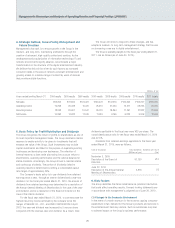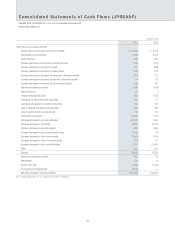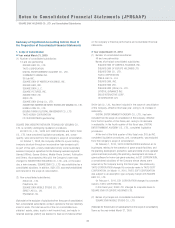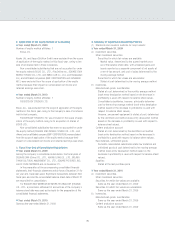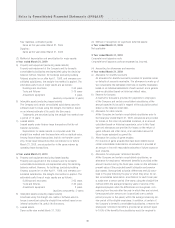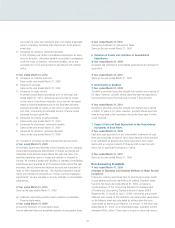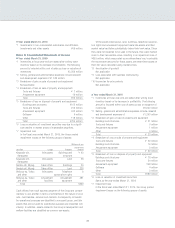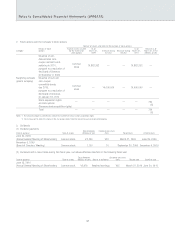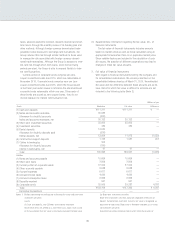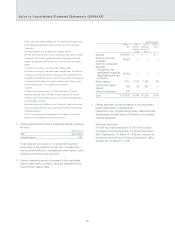Square Enix 2010 Annual Report Download - page 38
Download and view the complete annual report
Please find page 38 of the 2010 Square Enix annual report below. You can navigate through the pages in the report by either clicking on the pages listed below, or by using the keyword search tool below to find specific information within the annual report.
Raw materials, unfinished goods:
Same as the year ended March 31, 2009
Supplies:
Same as the year ended March 31, 2009
(2) Method of depreciation and amortization for major assets:
■ Year ended March 31, 2009
A) Property and equipment (excluding leased assets)
Property and equipment of the Company and its domestic
consolidated subsidiaries are depreciated using the declining-
balance method. However, for buildings (excluding building
fixtures) acquired on or after April 1, 1998, and overseas con-
solidated subsidiaries, the straight-line method is applied. The
estimated useful lives of major assets are as follows:
Buildings and structures 3-65 years
Tools and fixtures 3-15 years
Amusement equipment 3 years
(auxiliary components: 5 years)
B) Intangible assets (excluding leased assets)
The Company and certain consolidated subsidiaries amortize
software used in-house using the straight-line method, based
on an internal estimate of its useful life (five years).
Trademarks are amortized using the straight-line method over
a period of 10 years.
C) Leased assets
Leased assets under finance lease transactions that do not
transfer ownership.
Depreciation for leased assets is computed under the
straight-line method over the lease term with no residual value.
Among finance lease transactions that do not transfer owner-
ship, those lease transactions that commenced on or before
March 31, 2008, are accounted for in the same manner as
operating lease transactions.
■ Year ended March 31, 2010
A) Property and equipment (excluding leased assets)
Property and equipment of the Company and its domestic
consolidated subsidiaries are depreciated using the declining-
balance method. However, for buildings (excluding building
fixtures) acquired on or after April 1, 1998, and overseas con-
solidated subsidiaries, the straight-line method is applied. The
estimated useful lives of major assets are as follows:
Buildings and structures 3-65 years
Tools and fixtures 2-20 years
Amusement equipment 3 years
(auxiliary components: 5 years)
B) Intangible assets (excluding leased assets)
Amortized using the straight-line method. Software used in-
house is amortized using the straight-line method based on an
internal estimate of its useful life (five years).
C) Leased assets
Same as the year ended March 31, 2009
(3) Method of recognition for significant deferred assets:
■ Year ended March 31, 2009
Not applicable
■ Year ended March 31, 2010
Corporate bond issuance costs
Corporate bond issuance costs are expensed as incurred.
(4) Accounting for allowances and reserves:
■ Year ended March 31, 2009
A) Allowance for doubtful accounts
An allowance for doubtful accounts provides for possible losses
on defaults of accounts receivable. The allowance is made up of
two components: the estimated credit loss on doubtful receivables
based on an individual assessment of each account, and a general
reserve calculated based on historical default rates.
B) Reserve for bonuses
A reserve for bonuses is provided for payments to employees
of the Company and certain consolidated subsidiaries at the
amount expected to be paid in respect of the calculation period
ended on the balance sheet date.
C) Allowance for sales returns
At the Company and certain consolidated subsidiaries prior to
the fiscal year ended March 31, 2009, allowances are provided
for losses on the return of published materials, at an amount
calculated based on historical experience, prior to this fiscal
year and allowances are provided for losses on the return of
game software and other items, at an estimated amount of
future losses assessed by game title.
D) Allowance for closing of game arcades
For closures of game arcades that have been determined at
certain consolidated subsidiaries, an allowance is provided at
an amount in line with reasonable estimates of future losses on
such closures.
E) Allowance for employees’ retirement benefits
At the Company and certain consolidated subsidiaries, an
allowance for employees’ retirement benefits is provided at the
amount incurred during the fiscal year, based on the estimated
present value of the projected benefit obligation and pension
plan assets. Unrecognized actuarial differences are fully amor-
tized in the year following the year in which they arise. At cer-
tain consolidated subsidiaries, amortization for each fiscal year
is made over a certain period (five years) using the straight-line
method within the average remaining years of service of the
eligible employees when the differences are recognized, com-
mencing from the year after the year in which they are incurred.
Unrecognized prior service cost is amortized over a certain
period (one year or five years) within the average remaining ser-
vice period of the eligible employees. In addition, at certain of
the Company’s domestic consolidated subsidiaries, a reserve for
employees’ retirement benefits is provided at an amount equal
to 100% of the benefits the subsidiaries would be required to
Notes to Consolidated Financial Statements (JPNGAAP)
36


